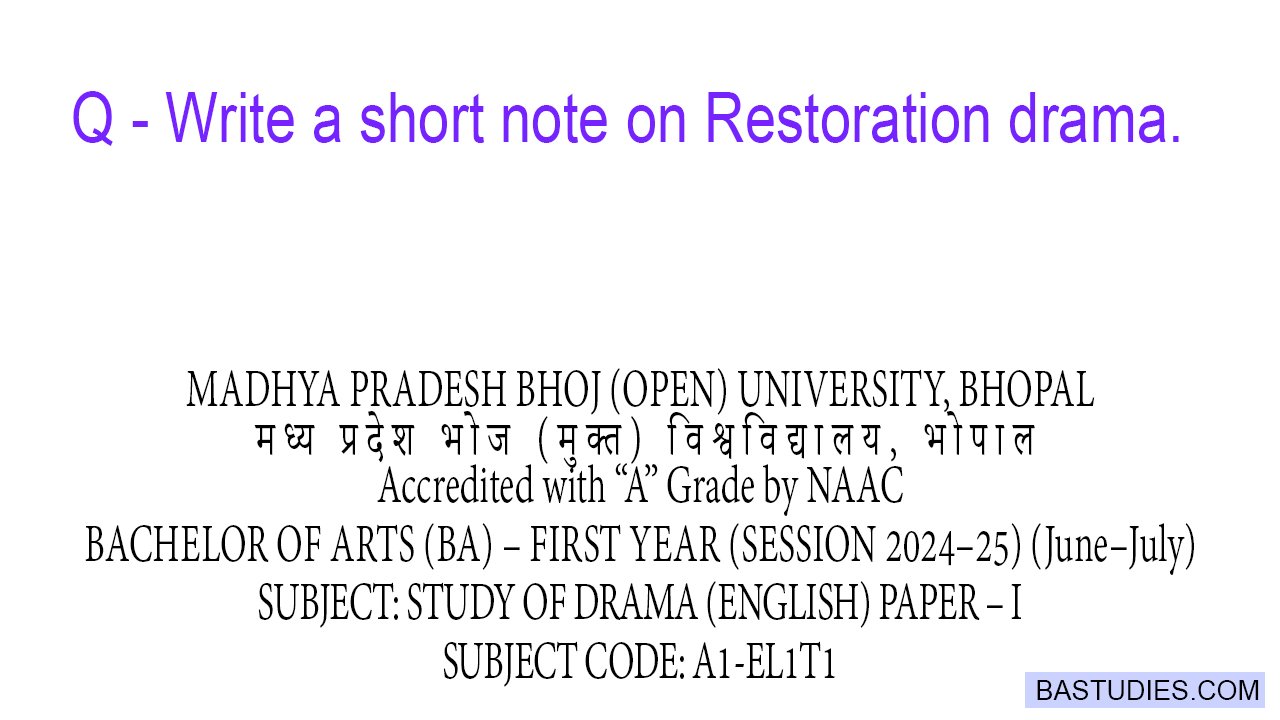Write a short note on Restoration drama
B.A. First Year – Study of Drama (English), Paper – I (Subject Code: A1-EL1T1)
Q – Write a short note on Restoration drama
ANSWER –
Short Note on Restoration Drama
Introduction
Restoration Drama refers to the body of English plays written and performed during the Restoration period (1660–1700), beginning with the restoration of King Charles II to the English throne after the Puritan rule under Oliver Cromwell. This period marks the revival of English theatre, which had been banned during the Puritan era (1642–1660) for being morally corrupt and sinful.
When Charles II was restored as monarch in 1660, theatres reopened, and drama once again flourished with a new spirit, style, and openness. The king himself was a patron of the arts and had lived in France during exile, where he was influenced by French theatrical tastes. These influences shaped the tone and form of Restoration theatre.
Key Characteristics of Restoration Drama
-
Restoration Comedy:
The most prominent and popular form of drama in this period was Restoration Comedy, also known as Comedy of Manners. These plays satirized the manners, fashions, and lifestyles of the upper class and often dealt with themes of love, sex, marriage, and social behavior. The characters were witty, often immoral, and engaged in clever dialogue filled with double meanings and irony. -
Wit and Satire:
Restoration plays were known for their sharp wit, intellectual humour, and satirical tone. They mocked hypocrisy in society, especially among the aristocracy, and exposed human follies and pretensions. -
Use of Heroic Drama:
Apart from comedies, heroic tragedies were also written during this time, characterized by elevated language, noble themes, and exaggerated heroic characters. These plays often dealt with love, honor, and political conflict. -
Introduction of Actresses:
For the first time in English theatre history, women were allowed to perform on stage. Female roles, which were earlier played by young boys, were now acted by women, adding realism and sensuality to the performances. -
Sexual Frankness:
Restoration drama is noted for its open treatment of sexuality and desire. Many plays contained bold themes, flirtation, and morally loose characters, which sometimes led to criticism for their indecency.
Major Playwrights of the Restoration Period
-
William Congreve – Known for The Way of the World and Love for Love, his plays are elegant examples of the Comedy of Manners.
-
George Etherege – His play The Man of Mode is a classic Restoration comedy.
-
Aphra Behn – One of the first professional female playwrights, known for The Rover.
-
John Dryden – A leading writer of heroic drama; his plays include All for Love and The Indian Emperor.
-
William Wycherley – Famous for The Country Wife, a highly controversial and witty play.
Conclusion
Restoration Drama reflects the spirit of a society that had emerged from political and religious suppression and was ready to enjoy life with openness and style. It emphasized wit, elegance, satire, and the complexities of human relationships, especially among the elite. Though criticized for its moral looseness, Restoration theatre remains an important chapter in the history of English drama for its literary innovation, theatrical reform, and introduction of female performers on stage.
Extra –
King Charles II – King Charles II of England (1630–1685) was the son of Charles I, who was executed during the English Civil War. After years in exile during Oliver Cromwell’s rule, Charles was restored to the throne in 1660, beginning the period known as the Restoration. His reign was marked by a return to monarchy, the reestablishment of the Church of England, and increased tensions between Catholics and Protestants.
He navigated political unrest, survived the Great Plague (1665), and the Great Fire of London (1666). Known for his charm and wit, Charles II had many mistresses and illegitimate children but no legitimate heir. Despite conflicts with Parliament, he maintained power through diplomacy and compromise. Nicknamed the “Merry Monarch” for his lively court and cultural patronage, he fostered arts and science, supporting the Royal Society. Charles died in 1685, converting to Catholicism on his deathbed, and was succeeded by his brother James II.
READ ALSO – Write a short note on Elizabethan Drama
READ ALSO – Give a brief character sketch of Mephistopheles in Dr Faustus
READ ALSO – Write a short note on Greek Tragedy
MORE Q&A – Write a short note on Elizabethan Drama

1 thought on “Write a short note on Restoration drama”